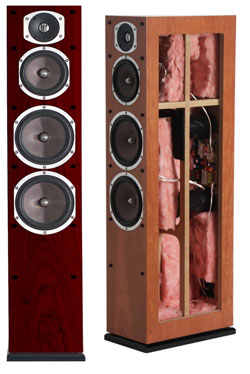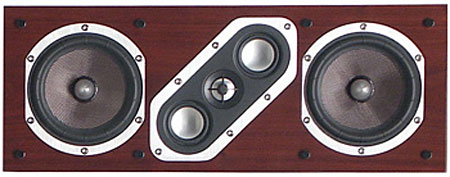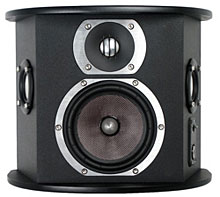Energy Reference Connoisseur RC-70 Surround Speaker System
 The new Reference Connoisseur line (designed in Canada but manufactured, like so many speakers these days, in China) is one step down from Energy's flagship range, the newest Veritas models. But it's a significantly bigger step down in price than in performance.
The new Reference Connoisseur line (designed in Canada but manufactured, like so many speakers these days, in China) is one step down from Energy's flagship range, the newest Veritas models. But it's a significantly bigger step down in price than in performance.
What's Inside
The review system features the biggest RC model, the RC-70 ($2000/pair), anchoring the left and right channels together with the horizontally configured RC-LCR ($600 each) in the center. As the latter model designation suggests, the RC-LCR can also be used as left and right channel speakers (or even surrounds), oriented vertically if desired. At the back were two of the RC series' small, variable radiation pattern RC-R surround speakers ($300 each). The subwoofer was the Energy S12.3 ($800). The system reviewed lists for a total of $4000.
The full-range Reference Connoisseur models are magnetically shielded. All of the drivers (tweeters excepted) have coated Kevlar cones and ribbed surrounds with an unusual, elliptical profile.
The RC-LCR (and the RC-R) also employs a 2" inverted aluminum dome midrange—perhaps the most unusual driver in the system. Two of these are used in the RC-LCR center channel speaker, flanking the main tweeter in a diagonal layout. If you're thinking, as I first did, that this 2" driver is one of those "full-range" units found in many of today's cheap computer speakers, you'd be wrong. According to Energy, this complex driver has a free air resonance of 200Hz (exceptionally low for such a small driver) with a response that extends flat to 8000Hz. But it isn't used over this full range. The specified crossover points (in the RC-LCR) are 600Hz and 2.5kHz.
The construction of this small midrange driver may be seen in the two accompanying photos, one showing the unmounted driver, the other an exploded diagram of its internal construction. The external inverted dome is actually part of a unique cone/dome combination, said to result in flat on-axis frequency response, wide dispersion, increased sensitivity, and low distortion.
Both this midrange and the main tweeter use small but powerful Neodymium magnets. This allows all three drivers to be positioned very close together. Both the midranges and tweeter also have their own critically damped rear chambers, allowing relatively low crossover points.
These design characteristics, together the 3-way configuration, are claimed to provide the RC-LCR with optimum dispersion. In theory this should minimize the off-axis response irregularities that plague most 2-way channel speakers that use a horizontal, woofer-tweeter-woofer orientation.
Two of these same inverted midrange domes are used in the RC-R surrounds as angled, side-firing drivers. A switch and level control allow the RC-R to be configured in one of three ways: as a dipole (with those side-mounted, inverted domes wired out-of-phase) as a bipole (with the side drivers in-phase), or as a direct radiator (with the side drivers shut off by reducing the level control to its minimum setting).
The Energy S12.3 subwoofer we received for the review employs a 12" ported driver using the same elliptical surround as the RC designs, but with a cover-all-the-bases cone composed of a polypropylene-Ceramic-Glass-Mica composite. The driver also has an impressive rated peak-to-peak excursion of 1.61-inches. (Technically, the S12.3 is not in the RC line; a line of Reference Connoisseur subwoofers, while not currently available, is scheduled for a spring 2006 launch).
The sub's amplifier is rated at 300-watts (continuous). Its controls include level (conveniently located on the front), phase, a defeatable crossover (50Hz-110Hz), and a power control that includes On, Off and Auto modes (the latter turns the sub on when it senses an input signal). Both a single line level and dual speaker level inputs are provided. It also has a non-detachable power cord, vinyl veneer, and a relatively light cabinet. I could easily pick up its 47 lbs. and move them around without help.

The Reference Connoisseur cabinets are solidly built and reinforced (see the cutaway photo). The review samples were finished in a gorgeous wood veneer Rosenut. Black Ash and Cherry are also available. The RC-R comes only in flat black, and the S12.3 only in a Black Ash. Dual five-way binding posts are also provided on both the RC-70 and RC-LCR for biwiring or biamping, if desired. The banana jacks in these terminals are blocked with those now ubiquitous and annoying plastic plugs. They may be easily removed after unscrewing the binding post nuts.
Setup
I set up the Reference Connoisseur speakers in the same locations that have worked well with other systems in my home theater room. The left and right RC-70s were just over 8' apart and located at either aside of my projection screen. The RC-LCR sat just below the screen, with the S12.3 sub positioned in the right front corner of the room. The surrounds, set to bipole mode, were in the back of the room just slightly closer to my main listening seat than the front speakers.
For music listening my projection screen was, as always, fully retracted so as not to interfere with the sound in any way, leaving nothing between the left and right RC-70s but the center RC-LCR. And the latter was on a low stand to position it below the screen when it's extended. The front speakers were several feet out from the front wall of my 15.5' x 26' x 8' home theater room, firing down the room's long dimension, and 3-4 feet from the sidewalls. The screen and the front speakers are displaced approximately one foot from the center axis of the room.
 The front RC-70s were toed in so that their axes crossed in front of the listening seats. I find that this arrangement provides the most uniform soundstage across a listening area that stretches from slightly to the left of center to slightly to the right of center. Aiming the left and right speakers straight ahead, as many audiophiles prefer, works fine for the center seat, but if you're not seated precisely in the middle the soundstage will be pulled toward the nearest speaker (though sound originating from the center channel speaker will not be affected). All three front speakers were auditioned with their grilles removed.
The front RC-70s were toed in so that their axes crossed in front of the listening seats. I find that this arrangement provides the most uniform soundstage across a listening area that stretches from slightly to the left of center to slightly to the right of center. Aiming the left and right speakers straight ahead, as many audiophiles prefer, works fine for the center seat, but if you're not seated precisely in the middle the soundstage will be pulled toward the nearest speaker (though sound originating from the center channel speaker will not be affected). All three front speakers were auditioned with their grilles removed.
Energy recommends at least 100 hours (!) of break-in time for the Reference Connoisseurs. The RC-70s had about that much time on them as I began my serious listening, but the other speakers in the system somewhat less (unless Energy broke-in the samples before sending them to us—something manufacturers rarely do).
Music Listening
I actually began my auditioning of the Energy's in conjunction with the review of the Outlaw Model 7125 amplifier. I had only one criticism of the Energy speakers when paired with the Outlaw: a little too much warmth through the upper bass region. That settled out with further use. While a trace of it remained, it was a rare intrusion.
As heard in two-channel stereo, without a subwoofer, I found the overall balance of the fully run-in RC-70s superb. The treble sparkled, but was never excessive or unnaturally bright. The RC-70s were perhaps even a little forgiving of bright recordings, and yet they didn't squeeze the life out of the music, as some polite, laid-back speakers tend to do. To reverse that old audiophile cliché, the RC-70s were not ruthlessly revealing, but they were revealing enough to discern differences in the equipment driving them—including the subtle high frequency variations heard when comparing the digital outputs of several DVD players. And while I heard an occasional trace of metallic flavoring from the speaker's aluminum-dome tweeter, at its best the top end of the RC-70 is as open, airy, and as detailed as you could wish for.
The midrange was clear and free of the usual suspects—boxiness, nasality, and other nasty, artificial-sounding colorations that are particularly distracting with human voices. Voices were, in fact, beautifully served by the RC-70, with soaring female voices and male vocals that were rich and full-bodied.
The RC-70s sounded neither "in your face" forward nor recessed, and produced a detailed, well-focused soundstage. I'm fortunate in that I get a strong phantom image between most speakers I've had in this room, and the RC-70s were no exception. They didn't produce a soundstage that extended beyond the far sides of the speakers, but then that isn't a common phenomenon in my room; I suspect the strong toe-in I use works against it. But if the recording provides a well-defined soundstage, a pair of RC-70s will give it to you. And while they don't provide the sort of depth that makes audiophiles (like me) salivate, the depth they do provide is realistic and satisfying.
























































